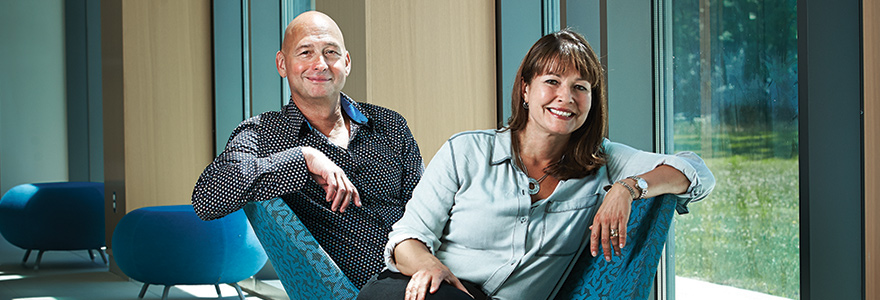In Touch with the Mind
Lisa Saksida, PhD, and Tim Bussey, PhD, are using touchscreens to revolutionize the way cognitive tests are performed
By Jesica Hurst, BA’14
"Because we study behaviour, the lab has to be quite big,” Lisa Saksida, PhD, explained as she and her partner Tim Bussey, PhD, walk through their brand new work environment at Schulich Medicine & Dentistry’s Robarts Research Institute. “We need a significant amount of space for the apparatus we use in our tests.”
The lab space itself is nothing outof- the-ordinary – it’s the equipment she refers to that makes such a statement. Rows and rows of touchscreen chambers take up the majority of the focus, and computers and screens that correspond with said chambers line a room that the husband-and-wife team has unofficially dubbed ‘Mission Control.’
The lab space is not exactly what comes to mind when you think ‘basic science.’ And that is because Bussey and Saksida have spent the past few decades revolutionizing the way cognitive tests are performed on mice and rat models – models of numerous neurodegenerative and psychiatric diseases, such as Alzheimer’s and Huntington’s, that affect hundreds of thousands of patients every day in Canada alone.
It was 1990 – around the time when the couple first met – when Bussey and Saksida first experimented with rat models and touchscreen chambers. They had used other methods before, but nothing had allowed them to study behaviour so effectively.
“We originally liked the touchscreen set-up because it was computer-automated, meaning you didn’t interfere while it was completing the tests, which made for much more accurate recordings,” Bussey said. “The set-up also allowed us to test the same way every time, so our results were consistent and replicable.”
The chambers the team now use have evolved since the 1990s, but the basic concept remains the same. On one end of the toaster oven-sized chamber is an iPadlike touchscreen used for the actual testing, and on the other end is an area for the distribution of a reward, which happens to be strawberry milkshake. Video cameras are also set up inside the chambers so the researchers can track what is happening live on corresponding computers.
“It was about 10 years ago that we extended this touchscreen approach from rat models to mouse models, because there are so many more mouse models of disease,” explained Saksida. “It was at that point when the popularity began to increase rapidly, and now more than 150 labs in North America are using our method.”
Mice placed in the chamber are put through a series of image-focused tests related to memory, learning and behaviour. The tests are easily translated into use with human patients as well, which increases the transfer of knowledge from preclinical studies to the clinic.
Even though Saksida and Bussey come from different education backgrounds, they have both always been interested in the basic, fundamental questions about how the brain works.
Saksida completed her undergraduate education in psychology at Western University before moving into work-related computer modelling and intelligent robotics. She eventually decided to leave the robots aside to focus on computation modelling of the brain, which brought her back to cognitive neuroscience.
Bussey’s path has been even less direct. After completing an undergraduate degree in chemistry, he worked as a professional musician for a number of years before deciding to go back to school to earn a degree in psychology. He put the touring life to rest once he discovered how much he enjoyed his work in biopsychology.
It is these diverse yet compatible skill sets that brought them together to create such a revolutionary technique, which they are using to learn more about cognitive impairment – something that can be just as troublesome for patients as other symptoms, and can occur even earlier.
“In Huntington’s, for example, you immediately think of issues with movement. Because the movement symptoms tend to dominate, the cognitive symptoms of neurodegenerative and psychiatric diseases are often left untreated,” Bussey said. “The earlier we can pick up on these cognitive deficits, the better position we are in for treatment.”
“It’s not even about coming up with new treatments – it’s about being able to pick up impairments at the earliest stage possible,” Saksida added.
Since joining Schulich Medicine & Dentistry in early 2016, the husband-andwife team has thoroughly enjoyed their time building their new lab and beginning collaborative projects with other researchers at the School. They are looking forward to what they will accomplish in the years to come at their new home.
“We have received such a warm welcome from all of Western, and we have had a lot of fun in the last year and a half getting things started,” Saksida said. “We are really excited to be here and to be able to collaborate with other like-minded individuals who enjoy the mysteries of science, just like we do.”









